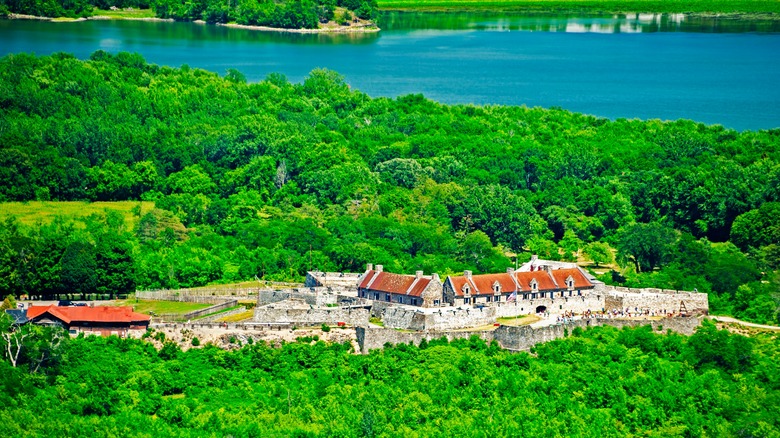A Historic Site Between New York And Vermont's Mountains Offers Great Lake Champlain Views
When you step through the imposing front gate, Fort Ticonderoga looks like it hasn't changed since the 1770s. The stone walls are still sturdy. The rooftops are still a warm red. The turrets and triangular towers — known as bastions — come together at sharp angles. The lawns are mown, the paving stones are smooth, and the windows all have glass panes in their mullions. To the delight of military history buffs, cannons are still positioned on the walls, aiming at the lake and surrounding forest. If a British officer were to time-travel to the present day, he might not even see much out of place.
Known locally as "Fort Ti" (pronounced "tie"), this magnificent "star-fort" stands in the middle of a 2,000-acre park on the eastern edge of New York State. The park is nestled in the Champlain Valley, between the Green Mountains of Vermont and the Adirondacks of New York, and the estate offers gorgeous views of Lake Champlain, which forms a glistening natural border between the two states. Since it first opened as a historic landmark in 1909, preservationists have taken great pains to restore Fort Ticonderoga to its original splendor, and the site has become a magnet for amateur historians and school groups over the past century. Each year, 70,000 people visit the fort; they climb the walls, take in the vistas, and watch costumed interpreters re-enact colonial military life. You could easily add it to a list of the best historic sites to visit in America.
The action-packed history of Fort Ticonderoga
Fort Ticonderoga stands at the confluence of Lake Champlain and Lake George, a patch of land that was of profound strategic importance during the French and Indian War. The French army spent four years building a stronghold called Fort Carillon, and they successfully defended the worksite against a British army of 16,000 men in 1758; the Battle of Carillon was considered the bloodiest battle of that war, and it took the British another year to finally commandeer the outpost and rename it.
When the American Revolution broke out in early 1775, the Continental Army needed a decisive victory, fast. The Redcoats had legions of well trained soldiers across the Thirteen Colonies, and the American forces consisted of mostly local farmers with muskets. The tide turned with the Green Mountain Boys, a militia from Vermont. Just a month after the Battle of Lexington, some 83 guerrillas snuck into Fort Ticonderoga and confronted the officer in charge. They took over the fort without firing a single shot, and a massive stockpile of weapons and ammunition fell into Patriot hands. This remains a point of pride in New York and Vermont, and Ethan Allen, leader of the Green Mountain Boys, became a legendary name.
Two years later, the British planned an aggressive siege of Ticonderoga. The Continental Commander Arthur St. Clair knew a lost cause when he saw one. He abandoned the fort, and his men narrowly escaped capture in the woods of Upstate New York. Given its importance to the revolutionary cause, Ticonderoga is much like this underrated National Park where you can learn more about U.S. history.
An action-packed present for road-trippers
Today, Fort Ticonderoga stands about four and a half hours north of New York City, a scenic and popular drive up the Hudson River Valley. This region is soaked in history, from the War of Independence to the Industrial Revolution and the eponymous art movement, and Fort Ticonderoga makes an illuminating stop along the way. Costumed interpreters and large-scale reenactments are common here, and the adjacent King's Garden is a beautiful 6-acre plot with traditional blooms and livestock. Kids will love to see old-school powder rooms and artillery up close, and pretty much everyone will delight in the views of Lake Champlain, one of the most beloved bodies of water in the Northeast. Guided tours point out specific architectural details and illustrate martial life in the 18th century.
If you're really into forts, consider a side-trip to the Crown Point Historic Site. Located just 15 minutes north of Ticonderoga, Crown Point was once one of the largest British forts in North America; no major battles were fought there, but the 7-acre enclosure was eventually abandoned. Today, the outer walls are covered in soft grass, and the skeletal remains of stone barracks are open to exploration. Unlike Ticonderoga, Crown Point is free to visit, and the fort has become a favorite spot for young children, who can freely wander and climb around the ruins. While adults are exploring these scenic region, consider visiting one of the most romantic getaway destinations in Upstate New York.


